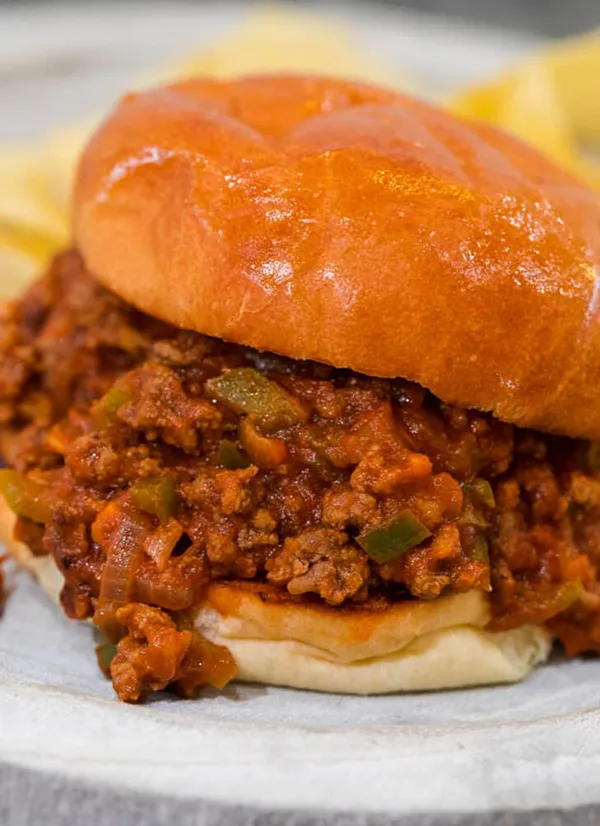
Picture this: You’re sitting down to dinner, a steaming plate of sloppy joes in front of you, the aroma filling the room. As you lift the spoon, a pair of hopeful eyes catches your attention from beneath the table. It’s your dog, drawn by the smell of savory ground beef and spices. While it’s tempting to share a bite of your meal with your furry friend, it’s important to pause and consider what’s safe for them to eat. Not all human foods are suitable for dogs, and what seems like a treat can sometimes pose risks. In this article, we’ll explore the classic ingredients of a sloppy joe and discuss why this popular dish might not be the best choice for your pet. We’ll also share some dog-friendly alternatives that let your pooch enjoy the flavors safely. So, before you give in to those pleading eyes, let’s find out how to treat your dog without compromising their health.
An Dogs Eat Sloppy Joes?
No, dogs should not eat sloppy joes. The traditional ingredients used in sloppy joes include several elements that are harmful to dogs, such as onions, garlic, and certain spices, which can cause gastrointestinal irritation and potentially serious health issues like hemolytic anemia.
Explanation: Sloppy joes are typically made with ground beef, onions, garlic, various seasonings, and a sauce that often contains sugar and high levels of salt. Onions and garlic are toxic to dogs; they contain compounds that can damage red blood cells, leading to anemia. The spices used in sloppy joes, like chili powder or mustard, can irritate a dog’s stomach, and the high fat content in the ground beef can lead to pancreatitis, a severe inflammation of the pancreas. Furthermore, the high salt and sugar content in sloppy joes can lead to additional health problems, such as obesity and sodium ion poisoning. Due to these risks, it’s best to avoid feeding sloppy joes to dogs and consider safer, dog-friendly alternatives for treats.
Read More: Can Dogs Eat Oatmeal Cream Pies?
What’s in a Sloppy Joe?

Sloppy Joes are a quintessential American dish known for their robust flavor and hearty texture. While recipes can vary, the core ingredients typically include ground beef, onions, tomatoes, bell peppers, and a rich blend of spices and seasonings. Here’s a closer look at these ingredients and their implications for canine health:
Common Ingredients in Sloppy Joes
- Ground Beef: The mainstay of most sloppy joe recipes, ground beef is high in protein, which is beneficial for dogs. However, the beef used in sloppy joes is often higher in fat, which can be a concern, particularly for dogs with sensitive stomachs or those prone to pancreatitis.
- Onions and Garlic: Regularly featured for their flavor-enhancing properties, both onions and garlic are toxic to dogs. They can cause gastrointestinal irritation and may lead to red blood cell damage.
- Tomatoes: While ripe tomatoes are generally safe for dogs in small quantities, large amounts can cause stomach upset. Moreover, the green parts of the tomato plant are toxic to dogs.
- Bell Peppers: These are typically safe for dogs and can be quite healthy as they are rich in vitamins A, E, and C.
- Spices: Common spices in sloppy joes include mustard, chili powder, and black pepper. While none of these are highly toxic, the spicy nature of these ingredients can irritate a dog’s digestive system.
Ingredients’ Impact on Dogs
- Beneficial: Plain cooked ground beef (with low fat) and bell peppers are safe and healthy for dogs in moderation. They provide essential proteins and vitamins that contribute to a balanced diet.
- Harmful: Onions, garlic, and excessive spices are the main culprits in sloppy joes that could harm your dog. Even small amounts of onions and garlic can be dangerous, making traditional sloppy joes a risky food for dogs.
- Cautionary: Ingredients like tomatoes should be given in moderation, ensuring they are ripe and free of any green parts.
Understanding the composition of sloppy joes helps pet owners make informed decisions about feeding their dogs. While some ingredients are outright harmful, others can be included in homemade dog food recipes that mimic the flavors of sloppy joes without the risks.
Read More: Can Dogs Eat Tamales? Understanding the Potential Risks and Benefits
Potential Risks of Feeding Sloppy Joes to Dogs
Sharing a plate of sloppy joes with your dog might seem like a treat for them, but this popular dish carries significant risks for canine health due to its ingredients. Here’s an overview of why some elements of a sloppy joe can be dangerous:
Onions and Garlic: Toxicity Risks
Onions and garlic are staples in many kitchens and essential for the robust flavor of sloppy joes. However, both onions and garlic contain compounds called disulfides and thiosulfates, which are toxic to dogs. These compounds can cause oxidative damage to red blood cells, leading to a condition known as hemolytic anemia. Symptoms might include weakness, lethargy, pale gums, and rapid breathing. The toxic effects can occur from both raw and cooked onions and garlic, making sloppy joes a potentially harmful dish for dogs.
Seasonings and Spices: Potential Digestive Irritants
Sloppy joes are flavorful partly due to their spices, such as chili powder, black pepper, and mustard. While these are not toxic in the same way as onions and garlic, they can still pose risks. Spices can irritate a dog’s digestive system, leading to symptoms like stomach upset, diarrhea, and vomiting. The capsaicin in chili powder, in particular, can be quite irritating and uncomfortable for dogs, making it advisable to keep spicy foods away from them.
Sugar and Salt Content: Harmful in High Quantities
The sauces used in sloppy joes often contain high levels of sugar and salt, which are harmful to dogs in large amounts. Excessive sugar can contribute to dental problems and obesity in dogs, while high salt intake can lead to increased thirst, urination, and even sodium ion poisoning. Symptoms of too much salt include vomiting, diarrhea, tremors, and seizures. It’s crucial to monitor the intake of these ingredients to maintain your dog’s health.
Fatty Foods: Risk of Pancreatitis
Ground beef, a primary component of sloppy joes, is typically high in fat, especially if it’s not lean. High-fat diets are a risk factor for pancreatitis in dogs, a serious condition that causes inflammation of the pancreas. Symptoms of pancreatitis include abdominal pain, vomiting, diarrhea, and lethargy. Feeding dogs fatty foods like the meat used in traditional sloppy joes can trigger this painful and potentially dangerous condition.
Given these risks, it’s clear that feeding dogs sloppy joes can lead to several health issues. It’s always best to stick to dog-specific foods or consult with a veterinarian for advice on safe human foods. If you’re eager to share a sloppy joe-like experience with your pet, consider preparing a special version with dog-safe ingredients.
Read More: Can Dogs Eat Yellow Rice?
Healthier Alternatives
While traditional sloppy joes may not be suitable for dogs, that doesn’t mean they have to miss out on a similar, tasty experience. Here are some ways to create dog-friendly alternatives that keep the spirit of sloppy joes alive without the associated health risks.
Suggestions for Making a Dog-Friendly Version of Sloppy Joes
- Use Lean Meats: Opt for lean ground beef or ground turkey, thoroughly cooked without any added spices or seasonings.
- Vegetables: Incorporate safe vegetables like carrots, peas, and cooked pumpkin. These add nutrients and fiber without the harmful effects of onions and bell peppers.
- Simple Seasonings: Instead of traditional sloppy joe seasonings, use a tiny pinch of turmeric or ginger for flavor, which are safe for dogs in small amounts and can provide anti-inflammatory benefits.
Alternative Ingredients That Are Safe and Nutritious for Dogs
- Sweet Potatoes: A healthy, fiber-rich carbohydrate alternative to sugary sauces.
- Brown Rice or Oats: These grains can serve as a filler to mimic the texture and bulk of a traditional sloppy joe mix while being gentle on a dog’s digestive system.
Simple Homemade Dog Food Recipes
- Dog-Friendly Sloppy Joe Mix: Combine lean ground beef with cooked sweet potatoes, peas, and carrots in a homemade low-sodium beef or bone broth. Serve this mixture over a small amount of brown rice or inside a hollowed-out, baked sweet potato for a fun and messy treat just like a traditional sloppy joe.
Conclusion
Traditional sloppy joes contain several ingredients that pose significant risks to dogs, including onions, garlic, high fat content, and spices that can upset a dog’s stomach or worse. These reasons make it clear why it’s not advisable to share your sloppy joe dinner with your pet.
However, by exploring pet-safe recipes and modifying traditional dishes, you can create enjoyable meal experiences for your dogs without the health risks. Always consult with a vet about introducing new foods to ensure they’re suitable for your dog’s specific health needs.
FAQs
- Can dogs eat cooked ground beef? Yes, dogs can eat cooked ground beef, provided it’s lean and cooked without harmful seasonings or oils.
- What symptoms should I look for if my dog eats something toxic? Watch for vomiting, diarrhea, lethargy, pale gums, and rapid breathing. These symptoms warrant immediate veterinary attention.
- How often can I treat my dog with homemade pet-safe meals? While it’s safe to occasionally treat your dog, their primary diet should be a balanced, vet-approved dog food. Treats (including homemade meals) should not constitute more than 10% of their total dietary intake. Always consult with your vet to ensure the homemade meals are nutritionally balanced.



